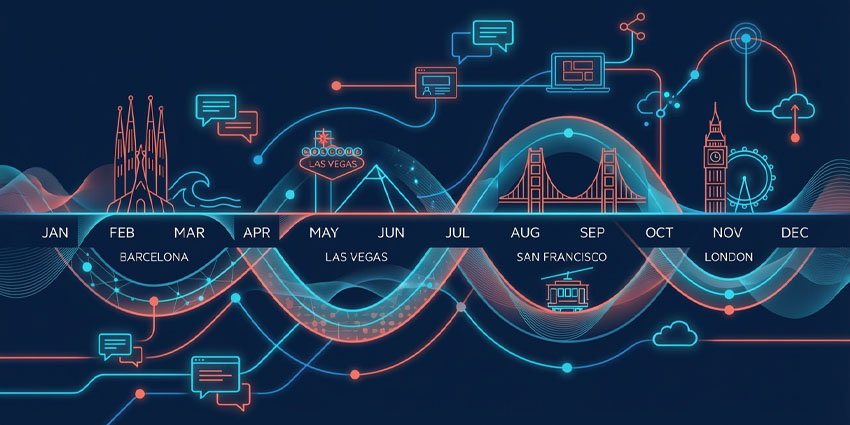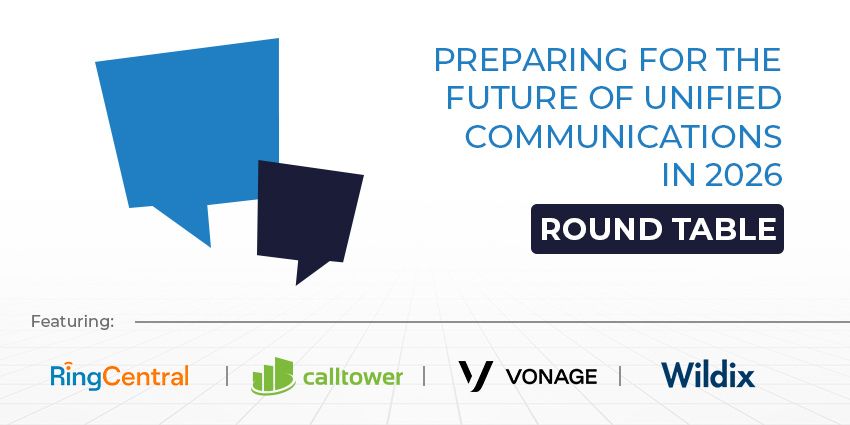In regulated industries, like finance, healthcare, and government, communications are never really “casual.” Everything from quick messages to client video calls comes with stakes linked to privacy, compliance, or reputation. That’s one of the reasons why the market for communication tools keeps changing, introducing new ways to customize tech stacks.
CPaaS is one of the major avenues worth exploring. It gives organizations agility, versatility, and control. By 2034, the market for CPaaS is expected to be worth more than $121 billion. A big part of that growth comes from growing adoption across healthcare, finance, and retail sectors.
But some organizations are looking beyond APIs, searching for solutions that allow them to control the brand experience, check every regulatory box, and bridge process gaps. Companies like Skyvera and Kandy, which offer white-label UC for regulated firms, could be an appealing option.
Why Regulated Firms Need Secure UC
These days, compliance isn’t just a box to check. It’s something connected to every conversation and workflow, particularly for regulated firms. A missed notification, a call that wasn’t recorded properly, or a missing audit trail can all be disastrous. These seemingly small things can cost organizations millions, delay operations, or trigger investigations that last months.
Unfortunately, compliance isn’t getting easier to manage. The latest stats prove it. In early 2025, GDPR fines exceeded €5 billion for the first time. It’s not just the financial cost organizations must consider, either. Every regulatory upset leads to brand damage, lost trust, and legal exposure.
You’d think that companies in regulated sectors would have figured out how to navigate these challenges by now. But realistically, many communication platforms weren’t built to be “compliance-first.” Most are designed for speed and simplicity, not accountability.
That means organizations end up patching together workarounds with third-party tools, consultants, and manual processes—all of which break down under pressure.
CPaaS-backed solutions, like white-label UC offerings from Kandy, give businesses the tools they need to build an ecosystem that works for them.
Understanding CPaaS and White-Label UC
Both developers and business leaders often love CPaaS for one simple reason: flexibility. Whether you’re adding real-time chat or voice APIs, embedding secure SMS authentication, or wiring in video calling, CPaaS provides building blocks.
The only potential downside for some organizations is that modularity often comes with missing parts. A CPaaS API might do a great job sending SMS messages, but you’ll need extra resources to enable authentication, tracking, and AI features.
White-label UC offerings, like the Kandy ecosystem, give service providers and developers the tools they need to wrap multiple APIs and features into a single branded solution. They can choose how APIs are deployed, which SIP trunks and carrier systems to build in, how to add microservices and data privacy solutions, and so much more.
Built for communications service providers, Kandy even offers pre‑packaged SDKs and no‑code “Wrapper” apps to speed up launch timelines.
What makes this interesting for regulated firms is that they can snap a branded app or portal around all the features: voice, messaging, presence, video, and collaboration. Compliance features come out of the box, including encryption, role-based access, logging, and even two-factor authentication services. That shifts the burden from in-house development teams to properly architected infrastructure that’s compliant by design.
The white-label UC model isn’t meant to replace CPaaS. It builds on it, embedding CPaaS components in a consistent, brand-aligned wrapper. The CPaaS engines still operate behind the scenes, delivering everything from SMS-based authentication to real-time call media. What’s different is that security and compliance land with the platform; they’re not tacked on later.
Building Compliance from the Ground Up
Here’s how a white-label UC or CPaaS solution can help regulated organizations secure their data properly without forcing them to reinvent the wheel.
First, “white-label” experiences offer real ownership. Firms can wrap their entire brand around tools for voice, messaging, video, and presence without spinning up a custom stack. You get:
- Built-in encryption and access controls mean that everything stays locked down, whether it’s a voice call, a message, or a file attachment. Only the right people can see the right things. A junior support agent won’t accidentally get access to archived recordings or sensitive chats; they’ll see only what they need to do their job.
- Activity logs and audit trails are part of the foundation. In heavily regulated industries, it’s not enough to have conversations. You need to prove they happened, who was involved, and when. The platform tracks all of it: logins, call joins, transcript downloads. It’s searchable, timestamped, and ready to hand over when audits roll around.
- Call recording and storage aren’t just about pressing “record.” They’re about doing it in a way that meets policy. Conversations can be captured automatically, stored securely, and kept only as long as necessary. Set the retention policy once, and the system takes care of the rest.
- Two-factor authentication (2FA) is expected globally, especially in sectors like banking and healthcare. Rather than adding it on later, it’s part of the flow. Before they can log in, a user gets a verification code via SMS or voice. It’s seamless, but it’s also essential.
- Flexible deployment makes a big difference, especially when data privacy laws are involved. Some organizations need a fully private, on-prem environment, while others prefer the speed of a managed cloud. With support for hybrid models, teams don’t have to compromise; they can choose what fits.
The Strategic Advantage of White-Label UC for Regulated Firms
Regulated firms have always had to be cautious, often at the expense of flexibility in communication. CPaaS and white-label UC platforms give organizations something rare: a way to move fast without losing control. They don’t have to trade off between branded experiences and compliant infrastructure. They can have both because the platform itself is designed to support that balance.
The result is:
- Full Brand Control: A lot of regulated companies want to own the front-end experience. Not just logos and colors, but the way communication feels across portals, mobile apps, and service layers. White-label UC gives them the tools to deliver client-facing environments that reflect their brand.
- Faster Launch Cycles: With pre-built features like secure messaging, real-time video, audit trails, and user management already baked in, teams can deploy faster. Kandy, for example, offers “wrapper” apps that can be customized and launched quickly without heavy development timelines.
- Reduced Compliance Risk: You don’t have to add security later. It’s already there from the start: encryption, logging, authentication, and policy controls are all built in and ready to go. That means less time wrestling with retrofits and more time staying ahead of the rules.
- Scalability Without Rework: Once the platform’s in place, scaling it is a matter of increasing capacity or adding new services. The compliance framework scales with it, so there is no need to redesign the system every time you expand teams or launch in a new region.
- Lower Total Cost of Ownership: Building a secure communications platform from scratch takes time, people, and legal reviews at every turn. With a white-label platform, much of that’s already been solved. The firm just needs to plug into it and layer on their specifics.
Industry Use Cases: Healthcare, Finance, Government
For industries under the microscope, communication is something that has to hold up in an audit. Here’s how organizations in healthcare, finance, and government can put CPaaS and white-label UC platforms to good use:
Healthcare: Keeping Patient Conversations Private
Hospitals handle sensitive information every day, including appointments, prescriptions, and consults, and privacy rules like HIPAA leave little room for error.
With a white-label UC platform, a hospital can run its own branded app that’s built for security. Patients get appointment reminders by SMS, follow up through encrypted messaging, or join a secure video call. Providers collaborate behind the scenes, knowing everything is logged, auditable, and stored according to policy.
Kandy, for example, supports HIPAA-aligned deployments with full control over where data lives, important when compliance depends on where and how things are hosted.
Finance: Compliance Without the Patchwork
Financial firms don’t just need to communicate; they need a record of it. Calls are usually recorded. Messages must be archived. The timeline of who said what matters.
With the right platform, a firm can offer secure, branded video meetings, use 2FA to verify users, and automatically store the session for compliance. Everything from logins to call history is timestamped and trackable, making it easier to meet FINRA or MiFID II rules, without having to weave together five separate tools.
Government: Messaging with Guardrails
Public agencies need to send alerts fast and run internal meetings securely. Off-the-shelf apps rarely adhere to the right data rules.
A white-label platform lets them launch their own communication system, emergency alerts go out by SMS or voice, while internal teams collaborate in a secure space where logs are kept, files are encrypted, and data stays inside approved infrastructure.
When Communication Needs to Hold Up Under Scrutiny
For regulated firms, every message, call, or video session lives in a space where policies apply, records matter, and threats are everywhere. An off-the-shelf UCaaS platform may not be an option for some organizations, but fortunately, there are other avenues to explore.
With the right platform, secure, branded tools that actually work for their users can be launched. CPaaS provides the engine, while a white-label UC layer provides control, structure, and peace of mind.
Kandy is one of the platforms getting this right. But it’s the model that’s worth paying attention to. For any organization navigating audits, privacy laws, or industry-specific standards, this kind of setup offers a way forward that doesn’t rely on patchwork fixes or vendor juggling.







